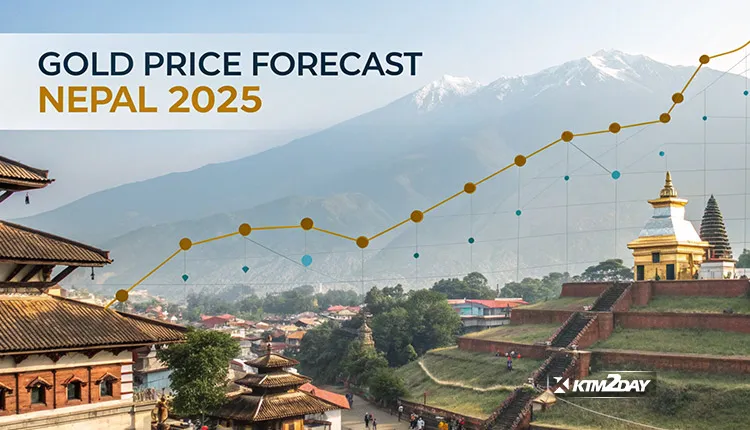Gold Price Forecast Nepal 2025: Will It Rise or Fall?


Kathmandu, Nepal – The Nepali gold market, a vibrant tapestry woven with cultural significance and economic reality, stands at a pivotal juncture. As 2025 unfolds, the question on every consumer, jeweler, and investor’s mind is: will gold prices continue their meteoric rise, or are we on the cusp of a significant correction? An in-depth analysis reveals a complex interplay of global and domestic factors that will dictate the trajectory of this precious metal in Nepal throughout the year.
Also Check : Gold Price in Nepal Today (Live Update)
A Look Back: The Unprecedented Surge
The gold market in Nepal has been on an aggressive upward trend since late 2023. What was once considered a steady, albeit appreciating, asset has transformed into a volatile commodity. To put this into perspective:
- October 2023: Hall-mark gold was approximately NPR 106,500 per tola (11.66 grams).
- October 2024: It had climbed to NPR 176,400 per tola.
- April 22, 2025: The price peaked at an astonishing NPR 197,900 per tola, with daily fluctuations reaching NPR 5,000-7,000.
- June 10, 2025: Today, the price of fine gold is around NPR 190,000 per tola, having seen both significant drops and surges in recent days.
This relentless surge in Nepal mirrors a global trend, driven primarily by pervasive geopolitical tensions, economic uncertainties, and shifting currency dynamics. The international price per ounce, which was around USD 1,864 in October 2023, has soared past USD 3,000, with some analysts reporting it exceeding USD 3,400 by June 2025.
Key Drivers Influencing Nepal’s Gold Price
Nepal’s gold market is not an isolated entity. Its prices are heavily influenced by a combination of international market trends and unique domestic factors. The Federation of Nepal Gold and Silver Dealers’ Association (FENEGOSIDA) sets daily prices based on a weighted average: approximately 75% international market trends (global spot prices in USD, adjusted for exchange rates) and 25% Indian market trends, along with additional costs like customs duty, profit margins, and retail markups.
Let’s delve into the specific factors at play for 2025:
1. Global Economic Uncertainty and Geopolitical Tensions: The primary catalyst for gold’s bullish run has been its role as a safe-haven asset. Ongoing global conflicts, such as the Russia-Ukraine war and the Israel-Hamas conflict, coupled with broader economic uncertainties like inflation fears and potential recession risks, have pushed investors worldwide to seek refuge in gold. This increased global demand directly translates to higher international prices, which Nepal, as a net gold importer, has to absorb. The U.S. administration’s tax policies and trade disputes, particularly with China, have also added layers of uncertainty, driving gold prices to new highs.
2. Central Bank Demand: A significant, and often underestimated, driver of gold’s appreciation is the sustained and robust demand from central banks globally. From 2022 onwards, central banks have been aggressively boosting their gold reserves. This strategic stockpiling, often seen as a diversification away from the U.S. dollar and a hedge against global instability, creates substantial underlying demand that keeps prices elevated. Goldman Sachs, for instance, predicts that central bank demand will continue to drive gold prices to new record highs in the long term, with some analysts forecasting gold to reach USD 3,700 per troy ounce by the end of 2025.
3. Nepali Rupee Depreciation: As Nepal is 100% reliant on gold imports, the exchange rate of the Nepali Rupee (NPR) against the US Dollar (USD) plays a crucial role. A weakening Nepali Rupee makes imported gold more expensive in local currency terms, even if international dollar prices remain stable. The Nepali Rupee has experienced periods of depreciation, including hitting an all-time low against the USD, which directly inflates the cost of gold for Nepali consumers. This factor has been a silent yet potent contributor to the domestic price surge.
4. Domestic Demand and Cultural Significance: Gold in Nepal is not merely a commodity; it is deeply embedded in the nation’s cultural fabric. Weddings, festivals (like Teej, Dashain, Tihar), and other auspicious occasions fuel a consistent demand for gold jewelry. Furthermore, for many Nepali households, gold remains a preferred form of tangible savings and wealth preservation, especially in the absence of more sophisticated investment vehicles readily accessible to the general public. While record-high prices have somewhat dampened demand, pushing daily transactions from 40-50 kilos to 15-20 kilos during wedding seasons, this underlying cultural affinity ensures a baseline demand that supports prices.
5. Import Duties and Supply-Side Constraints: Nepal levies a 10% customs duty on gold imports, which adds to the final consumer price. While neighboring India recently slashed its gold import duty to 15%, narrowing the duty gap with Nepal (which historically led to significant smuggling from India), the cumulative effect of import duties and retail markups (12-18% for jewelry) means that Nepali gold prices are often higher than international benchmarks. Additionally, global supply chain disruptions, labor shortages in mining operations, and tighter climate change regulations can lead to less gold reaching the market, further exacerbating price pressures in import-reliant nations like Nepal.
6. Inflation and Interest Rates: The relationship between gold, inflation, and interest rates is nuanced. Gold is often considered a hedge against inflation. When inflation erodes the purchasing power of fiat currencies, investors often turn to gold. Nepal’s inflation, if it remains sticky or surges unexpectedly, could further bolster gold’s appeal. However, rising interest rates can make interest-bearing assets more attractive, increasing the opportunity cost of holding non-yielding gold. Therefore, Nepal Rastra Bank’s (NRB) monetary policy and prevailing interest rate environment will also play a role. While NRB has allowed commercial banks to accept gold as interest-earning deposits, the overall impact on market supply and demand is still evolving.
Forecast for Gold Prices in Nepal 2025: Rise or Fall?
Based on the prevailing global and domestic economic indicators and expert analyses, the dominant sentiment points towards a continued upward trend for gold prices in Nepal through 2025, albeit with periods of significant volatility.
- Bullish Projections:
- Many analysts predict that international gold prices could reach USD 3,500 to USD 3,700 per ounce by mid-to-end 2025, driven by ongoing geopolitical tensions, sustained central bank demand, and potential inflation pressures. Some even suggest a high-risk scenario could see gold touching USD 4,500 per ounce.
- Translating this to the Nepali market, FENEGOSIDA has forecasted that prices in Nepal may cross NPR 200,000 per tola by mid-2025 if current trends persist. Given the current price of NPR 190,000 per tola, this projection seems plausible within the coming months.
- The consistent depreciation of the Nepali Rupee against the USD will further contribute to higher local prices for imported gold.
- Factors Moderating the Rise / Potential for Correction:
- While a sustained fall seems less likely given current global dynamics, a significant correction is not entirely out of the question. Experts warn that rapid price spikes can lead to equally rapid collapses.
- Subsides in Global Conflicts: A major de-escalation or resolution of key geopolitical conflicts could diminish gold’s safe-haven appeal, leading to a pull-back in prices.
- Economic Stability and Interest Rate Hikes: If global economies stabilize and central banks aggressively raise interest rates to combat inflation, making other investments more attractive, gold’s allure might wane.
- Improved Gold Supply: Any significant increase in global gold production or easing of supply chain issues could slightly ease price pressures.
- Government Policy Adjustments: While less likely to dramatically alter the overall trend, any changes in Nepal’s customs duties or import policies could have a localized impact on pricing.
Impact on Nepali Society and Economy
The soaring gold prices have profound implications for Nepal:
- Cultural and Household Strain: The increased cost of gold significantly strains household budgets, especially during wedding seasons. Families are finding it increasingly difficult to afford traditional gold jewelry, leading to financial stress and potentially altering long-standing cultural practices.
- Trade Deficit and Foreign Exchange Reserves: As a net importer, Nepal’s gold import bill has risen substantially. While imports saw a slight decline in FY 2023-24 compared to previous years (NPR 51.53 billion vs. NPR 63.19 billion in FY 2021-22), higher unit prices still mean a considerable outflow of foreign exchange, exacerbating the nation’s trade deficit and putting pressure on foreign exchange reserves.
- Informal Lending and Pawnshops: The rising value of gold has invigorated Nepal’s informal lending sector. Gold pawnshops offer quick loans, albeit at higher interest rates (18-24% per annum), providing a readily accessible but often risky option for those needing immediate funds against their gold collateral.
- Investment Landscape: While gold has traditionally been a primary investment avenue, its current volatility and high entry barrier are making some experts caution against it. Unlike other markets, Nepal lacks sophisticated gold investment vehicles like Gold ETFs or sovereign gold bonds, limiting options for diversified and regulated gold exposure. Other investment avenues like real estate (appreciating at 27.7% annually in Kathmandu) and fixed deposits (offering 9-11% returns) are being highlighted as potentially more stable alternatives.
Conclusion
The gold market in Nepal in 2025 is poised for continued buoyancy, largely propelled by global uncertainties and the enduring cultural significance of gold within the country. While predictions of gold crossing NPR 200,000 per tola appear increasingly likely, consumers and investors must remain vigilant. The market will undoubtedly experience significant volatility, characterized by sharp daily fluctuations.
For the average Nepali, buying gold at these elevated levels presents both a cultural necessity and a financial dilemma. Diversification of investments, careful consideration of market timing (e.g., avoiding peak festive seasons), and close monitoring of both international gold prices and the NPR-USD exchange rate will be crucial. While gold continues to be a beacon of stability for many, especially in uncertain times, its increasingly steep cost demands a pragmatic and informed approach to navigate this golden storm in Nepal’s evolving economic landscape.















